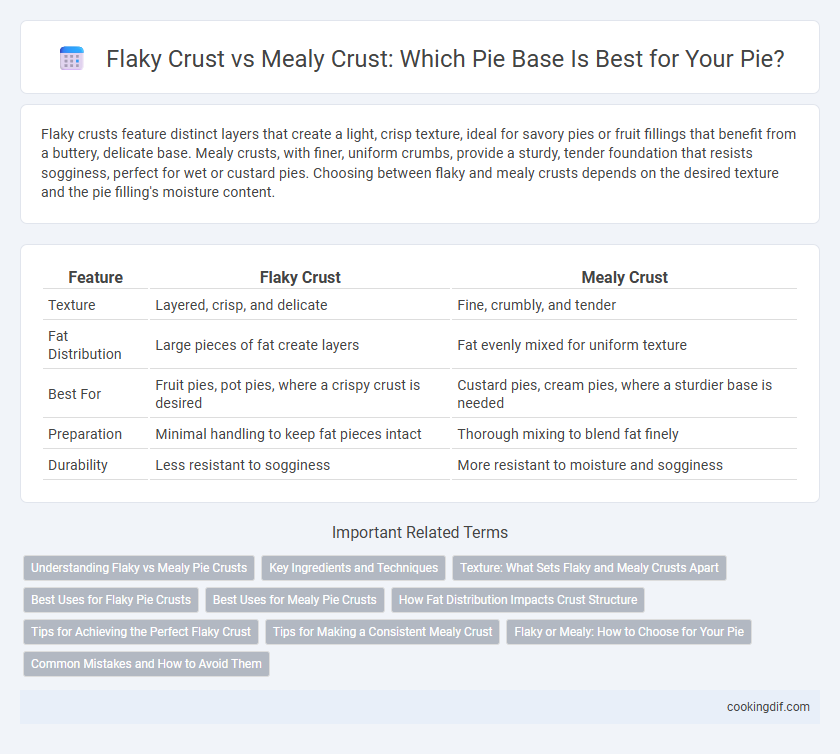Flaky crusts feature distinct layers that create a light, crisp texture, ideal for savory pies or fruit fillings that benefit from a buttery, delicate base. Mealy crusts, with finer, uniform crumbs, provide a sturdy, tender foundation that resists sogginess, perfect for wet or custard pies. Choosing between flaky and mealy crusts depends on the desired texture and the pie filling's moisture content.
Table of Comparison
| Feature | Flaky Crust | Mealy Crust |
|---|---|---|
| Texture | Layered, crisp, and delicate | Fine, crumbly, and tender |
| Fat Distribution | Large pieces of fat create layers | Fat evenly mixed for uniform texture |
| Best For | Fruit pies, pot pies, where a crispy crust is desired | Custard pies, cream pies, where a sturdier base is needed |
| Preparation | Minimal handling to keep fat pieces intact | Thorough mixing to blend fat finely |
| Durability | Less resistant to sogginess | More resistant to moisture and sogginess |
Understanding Flaky vs Mealy Pie Crusts
Flaky pie crusts consist of larger, solid fat pieces that create layered, tender textures ideal for fruit pies, while mealy crusts use finely ground fat for a crumbly, sturdy base perfect for custard or cream pies. Temperature control and type of fat play crucial roles in determining crust texture, with cold butter or shortening promoting flakiness and thorough fat incorporation leading to mealiness. Selecting the appropriate crust depends on the desired filling consistency and texture to complement the overall pie experience.
Key Ingredients and Techniques
Flaky crusts for pie bases rely on cold, solid fats like butter or shortening cut into flour to create distinct layers that puff and separate during baking. Mealy crusts use fats fully rubbed into the flour, producing a uniform, crumbly texture ideal for juicy fruit fillings or custards preventing sogginess. Precise chilling, minimal handling, and appropriate fat-to-flour ratios are essential techniques influencing the crust's final texture and structural integrity.
Texture: What Sets Flaky and Mealy Crusts Apart
Flaky crusts feature distinct, layered textures achieved by incorporating cold butter or fat into the dough, which melts during baking and creates pockets of air. Mealy crusts have a finer, crumbly texture resulting from thoroughly blending fat into flour, leading to a more tender and dense base. This textural difference affects the pie's overall mouthfeel, with flaky crusts offering crispness and layers, while mealy crusts provide a soft, buttery foundation perfect for juicy fillings.
Best Uses for Flaky Pie Crusts
Flaky pie crusts excel in recipes where a light, crisp texture complements the filling, such as fruit pies and tarts that benefit from a delicate, buttery crunch. Their high fat content, typically from butter or shortening, creates layers that bake into a tender, airy structure ideal for holding juicy or soft fillings without becoming soggy. Flaky crusts are less suited for custard or cream pies, where a firm base is needed to withstand softer fillings.
Best Uses for Mealy Pie Crusts
Mealy pie crusts, characterized by their fine, crumbly texture and higher fat-to-flour ratio, excel in creating sturdy bases that resist sogginess, making them ideal for custard pies and fruit pies with juicy fillings. Their dense structure provides excellent moisture barriers, preserving the integrity of wet or soft ingredients during baking. This crust type is preferred for savory pies as well, ensuring a tender yet robust foundation that holds up well under rich fillings like chicken pot pie or quiche.
How Fat Distribution Impacts Crust Structure
Fat distribution plays a crucial role in determining whether a pie crust turns out flaky or mealy. In flaky crusts, larger, uneven fat pieces create distinct layers as they melt during baking, resulting in a tender, airy texture. Mealy crusts have finely incorporated fat that blends uniformly with flour, producing a denser, crumbly base ideal for holding wet fillings.
Tips for Achieving the Perfect Flaky Crust
For a perfect flaky pie crust, use cold butter or shortening cut into small, pea-sized pieces to create distinct layers during baking. Handle the dough minimally and avoid overworking it to prevent developing gluten, which causes toughness. Chilling the dough thoroughly before rolling helps maintain the structure, ensuring the pie crust bakes up flaky and tender.
Tips for Making a Consistent Mealy Crust
Achieving a consistent mealy crust requires finely grinding the fat into the flour until the mixture resembles coarse cornmeal, which helps create a tender, crumbly texture ideal for fruit pies. Use cold ingredients, handle the dough minimally, and avoid overworking it to prevent gluten development that would lead to toughness. Chilling the dough thoroughly before rolling ensures a delicate, flaky result while maintaining the mealy consistency desired for a robust pie base.
Flaky or Mealy: How to Choose for Your Pie
Flaky crusts offer a tender, layered texture achieved by incorporating cold butter in small chunks, ideal for fruit pies where a light, crisp base complements the filling. Mealy crusts, made by thoroughly blending butter into flour until it resembles coarse meal, provide a more crumbly and sturdy foundation, perfect for custard or cream pies that require less moisture absorption. Choosing between flaky or mealy depends on the pie type and desired texture, with flaky crusts enhancing light, juicy fillings and mealy crusts supporting dense, wet fillings without becoming soggy.
Common Mistakes and How to Avoid Them
Common mistakes when making flaky crust include overworking the dough, which causes gluten development and reduces flakiness, and using warm butter instead of cold, leading to soggy texture. For mealy crusts, excessive mixing can result in a dense, crumbly base rather than tender and smooth. Avoid these errors by handling the dough gently, keeping ingredients cold, and resting the dough adequately before baking to achieve the desired crust texture.
Flaky crust vs mealy crust for pie bases Infographic

 cookingdif.com
cookingdif.com